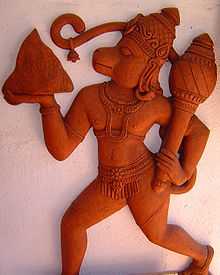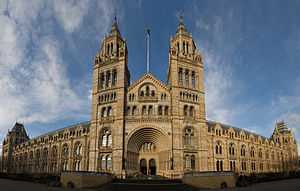Terracotta



Terracotta, terra cotta or terra-cotta (Italian: "baked earth",[1] from the Latin terra cotta), a type of earthenware, is a clay-based unglazed or glazed ceramic,[2] where the fired body is porous.[3][4][5][6] Its uses include vessels (notably flower pots), water and waste water pipes, bricks, and surface embellishment in building construction, along with sculpture such as the Terracotta Army and Greek terracotta figurines. The term is also used to refer to items made out of this material and to its natural, brownish orange color, which varies considerably. In archaeology and art history, "terracotta" is often used to describe objects such as figurines, not made on a potter's wheel. Objects made on a wheel from the same material, are called pottery; the choice of term depends on the type of object rather than the material.
Production and properties

An appropriate refined clay is formed to the desired shape. After drying it is placed in a kiln or atop combustible material in a pit, and then fired. The typical firing temperature is around 1,000 °C (1,830 °F). The iron content gives the fired body a yellow, orange, red, "terracotta", pink, grey or brown color. Fired terracotta is not watertight, but surface-burnishing the body before firing can decrease its porousness and a layer of glaze can make it watertight. It is suitable for in-ground use to carry pressurized water (an archaic use), for gardenware or building decoration in tropical environments, and for oil containers, oil lamps, or ovens. Most other uses, such as for tableware, sanitary piping, or building decoration in freezing environments, require the material to be glazed. Terracotta, if uncracked, will ring if lightly struck. Some types of terracotta are created using recycled terracotta ("grog").
History
Terracotta was the only ceramic produced by Western and pre-Columbian people until the 14th century, when European higher fired stoneware began production. Terracotta has been used throughout history for sculpture and pottery as well as for bricks and roof shingles. In ancient times, the first clay sculptures were dried (baked) in the sun after being formed. They were later placed in the ashes of open hearths to harden, and finally kilns were used, similar to those used for pottery today. However, only after firing to high temperature would it be classed as a ceramic material.
In art history
Terracotta female figurines were uncovered by archaeologists in excavations of Mohenjo-daro, Pakistan (3000-1500 BC). Along with phallus-shaped stones, these suggest some sort of fertility cult and a belief in a mother goddess.[7] The Burney Relief is an outstanding terracotta plaque from Ancient Mesopotamia of about 1950 BC.
The ancient Greeks' Tanagra figurines were mass-produced mold-cast and fired terracotta figurines. Significant uses of terracotta have included Emperor Qin Shi Huang's Terracotta Army of China, built in 209–210 BC.
Precolonial West African sculpture also made extensive use of terracotta.[8] The regions most recognized for producing terracotta art in that part of the world include the Nok culture of central and north-central Nigeria, the Ife/Benin cultural axis in western and southern Nigeria (also noted for its exceptionally naturalistic sculpture), and the Igbo culture area of eastern Nigeria, which excelled in terracotta pottery. These related, but separate, traditions also gave birth to elaborate schools of bronze and brass sculpture in the area.
French sculptor Albert-Ernest Carrier-Belleuse made many terracotta pieces, but possibly the most famous is The Abduction of Hippodameia depicting the Greek mythological scene of a centaur kidnapping Hippodameia on her wedding day. American architect Louis Sullivan is well known for his elaborate glazed terracotta ornamentation, designs that would have been impossible to execute in any other medium. Terracotta and tile were used extensively in the town buildings of Victorian Birmingham, England.
In chemistry
In chemistry, pieces of terracotta are used as a heterogeneous catalyst to "crack" long-chain alkanes. This process is useful for obtaining products, such as gasoline or petrol, from less useful ones, such as highly viscous long chain alkanes.
Advantages in sculpture
As compared to bronze sculpture, terracotta uses a far simpler process for creating the finished work with much lower material costs. Reusable mold-making techniques may be used for series production. Compared to marble sculpture and other stonework the finished product is far lighter and may be further glazed to produce objects with color or durable simulations of metal patina. Robust durable works for outdoor use require greater thickness and so will be heavier, with more care needed in the drying of the unfinished piece to prevent cracking as the material shrinks. Structural considerations are similar to those required for stone sculpture.
-

Relief from Buddhist Monument. The Walters Art Museum.
-

The Etruscan "Sarcophagus of the Spouses", at the National Etruscan Museum.
-

The Bell Edison Telephone Building, Birmingham, England.
-

The Natural History Museum in London has an ornate terracotta façade typical of high Victorian architecture. The carvings represent the contents of the Museum.
See also
- Architectural terracotta
- Cittacotte
- Glazed architectural terracotta
- List of colors
- Majapahit Terracotta
- Kulhar (traditional terracotta cups)
References
- ↑ Merriam-Webster.com
- ↑ OED, "Terracotta"
- ↑ ‘Diagnosis Of Terra-Cotta Glaze Spalling.’ S.E. Thomasen, C.L. Searls. Masonry: Materials, Design, Construction and Maintenance. ASTM STP 992 Philadelphia, USA, 1988. American Society for Testing & Materials.
- ↑ ‘Colour Degradation In A Terra Cotta Glaze’ H.J. Lee, W.M. Carty, J.Gill. Ceram.Eng.Sci.Proc. 21, No.2, 2000, p.45-58.
- ↑ ‘High-lead glaze compositions and alterations: example of byzantine tiles.’ A. Bouquillon. C. Pouthas. Euro Ceramics V. Pt.2. Trans Tech Publications, Switzerland,1997, p.1487-1490 Quote: “A collection of architectural Byzantine tiles in glazed terra cotta is stored and exhibited in the Art Object department of the Louvre Museum as well as in the Musee de la Ceramique de Sevres.”
- ↑ 'Industrial Ceramics.' F.Singer, S.S.Singer. Chapman & Hall. 1971. Quote: "The lighter pieces that are glazed may also be termed 'terracotta.'
- ↑ Jacob Neusner, ed. World Religions in America. Louisville: Westminster John Knox Press, 2003.
- ↑ H. Meyerowitz; V. Meyerowitz (1939). "Bronzes and Terra-Cottas from Ile-Ife". The Burlington Magazine for Connoisseurs 75 (439), 150-152; 154-155.
External links
| Wikimedia Commons has media related to Terracotta. |
| Look up terracotta in Wiktionary, the free dictionary. |
- Article on terracotta in Victorian and Edwardian Terracotta Buildings
- Bibliography, Smithsonian Institution, Ceramic Tiles and Architectural Terracotta
- Tile Heritage Foundation (US)
- Friends of Terra Cotta, non-profit foundation to promote education and preservation of architectural Terracotta
- Tiles and Architectural Ceramics Society (UK)
- La Terracotta (IT)
- Guidance on Matching Terracotta Practical guidance on the repair and replacement of historic terracotta focusing on the difficulties associated with trying to match new to old
| ||||||||||||||||||||||||||
| ||||||||||||||||||||||||||||||||||||||||

